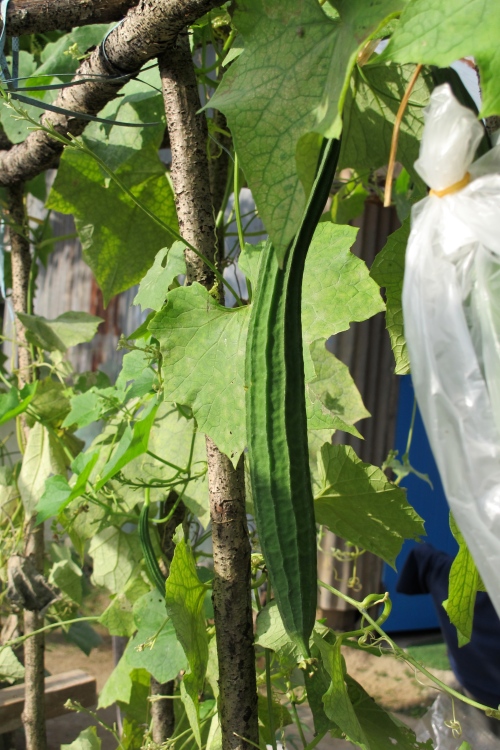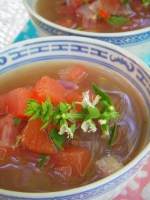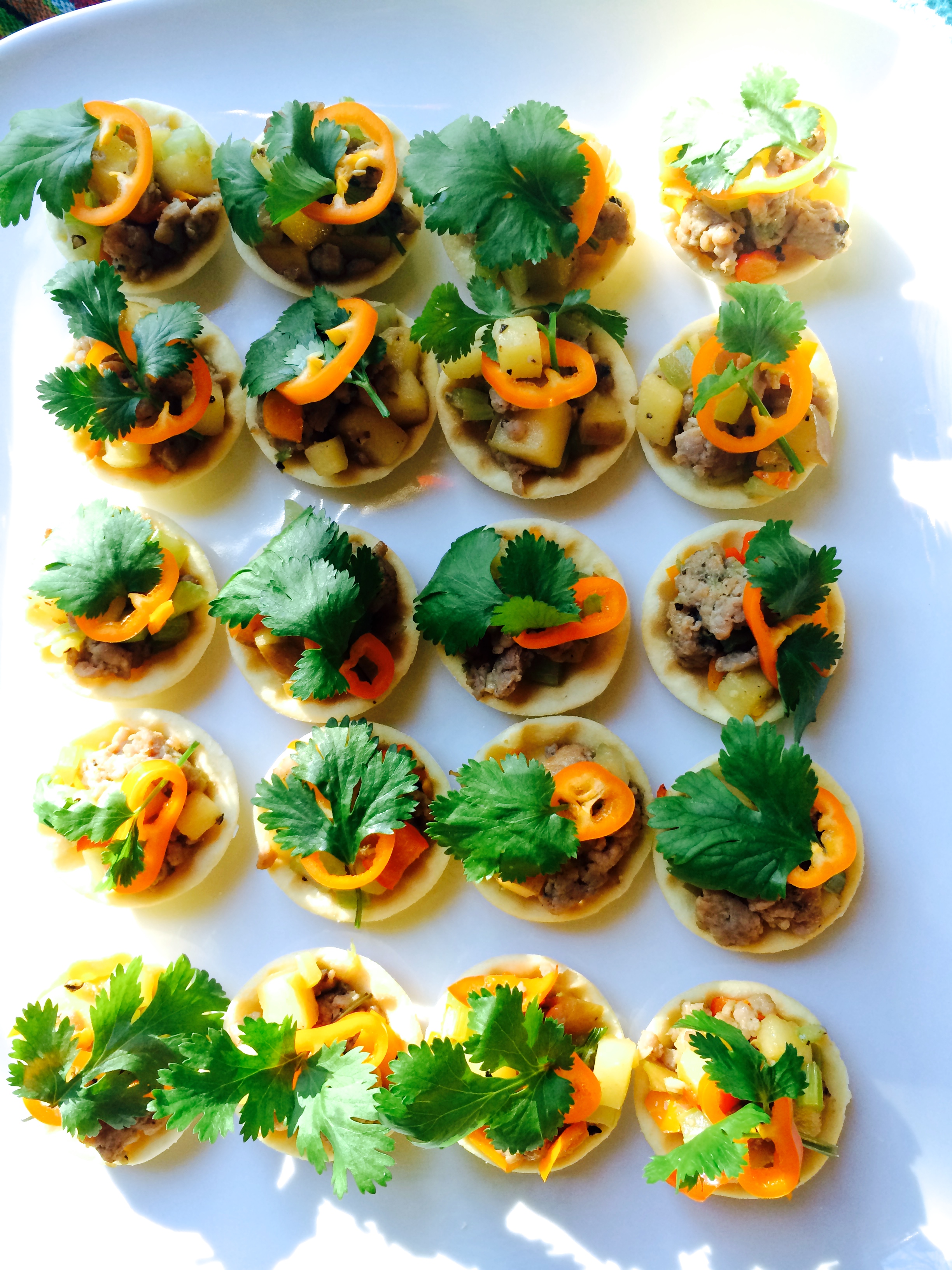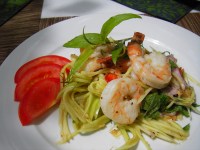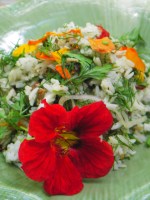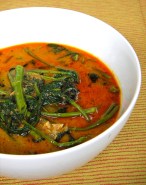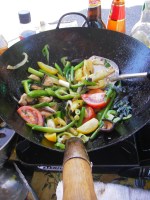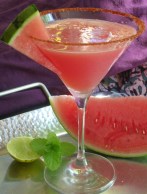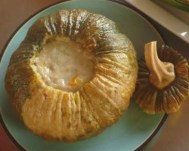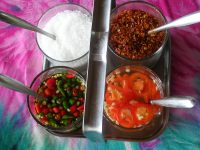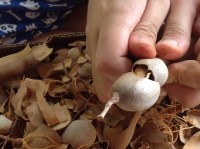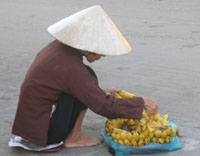What is a Fruit, Eaten as a Vegetable, and Used as a Sponge?
Wait—you are eating luffa? Yes, in Thailand luffa fruit is eaten at a young stage as a vegetable. It is soft, sweet and aromatic after cooking, either in a stir-fry or a soup dish. We eat the whole fruit except for the skin.
When I have a craving for luffa as a vegetable, I only choose the youngest luffa available. As the fruit gets older, the fibrous veins becomes more visible and tough and the flesh gets more airy and dries out to become a sponge. Farmers leave many healthy-looking luffa fruit longer on the trellis in order to harvest seeds and sponges as the annual vine grows old, dies, and dries up. The last harvest for the plant is healthy seeds and luffa sponges for bathing or cleaning pots and pans.
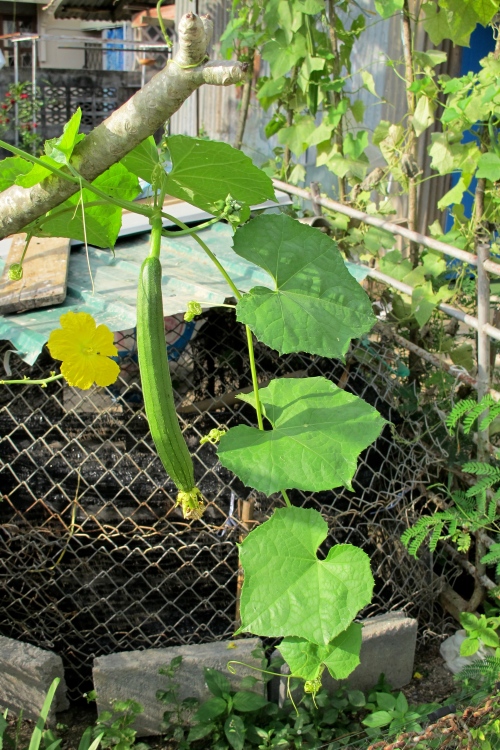
บวบหอม – Smooth Luffa – Luffa aegistiaca
We enjoy two species of luffa as a vegetable in tropical and subtropical countries. The above luffa is บวบหอม – buap hom – Sponge Luffa or Smooth Luffa. Below is the บวบเหลี่ยม – bump liam – Ridged Luffa or Angled Luffa.
Growing up in Thailand I felt that what makes a Thai village scene beautiful is walking around and seeing both kinds of luffa growing in and around granny’s home, either on the fences or the chicken penthouse or on a tree. And one doesn’t need a fancy vegetable garden to grow them, just two square feet of fertile ground, routine watering, then a bit of training to get the vine to climb up a twig or fence as it grows. After that it can take care of itself and all you have to do is admire the yellow flowers, harvest the luffa, collect seeds for the next season and enjoy a supply of sponges.
This picture was taken a few years back when I visited my mom and uncle and we walked around my village in a circle. The angled luffa is young, long, and round with ridges. This one is a perfect size for harvesting. It could be from 1 to 1 and 1/2 inches in diameter and 8 to 12 inches long. The yellow flowers were bright against the dark green guard hanging on the chicken coop to provide shade for chickens. I trust that the yield of luffas from this single plant provided many meals, stir-fried, in a country-style soup, or served with Nam Prik – Thai Chili Dip.
Step-by-Step: How to Peel and Cut Luffa
One year when I visited mom I found her in the kitchen just about to prepare stir-fried luffa with egg for lunch. Because I wanted to share the technique and recipe with you and all my blog followers, I asked her if she could do this in slow motion and let me interrupt her so I could take photos of her peeling and cutting luffa the way everyone from our Thai village always did. I want to share with you this treasured culinary moment in my mom’s kitchen.
The luffa is actually related to the cucumber family. They are alike in many ways but the luffa is softer. We use a cucumber peeler to peel the ridged skin.
After peeling and rinsing, we do the oblique cutting or roll-cutting.
The reason we love luffa so much is that it is succulent, moist, sweet and tender. Therefore we don’t need many ingredients in this stir-fried dish. We often enhance the flavor with some protein like egg, prawn or pork, then a little fish sauce or soy sauce for salt. The taste has a hint of zucchini and cucumber. It has a delightful silky smooth texture that is soft, but firmer than a marshmallow.
Both species of luffa can be cooked in the same way. There is not a big difference between the two, but I prefer angled luffa over smooth luffa as it is more succulent and sweet. This recipe, and the photographs were recorded many years ago in my mom’s kitchen in Phuket. It captured our fine day visiting and savoring real Thai home cooking.
Stir-fried Angle Luffa with Egg
Buab Phad Khai
บวบผัดไข่
Serves: 4
Like any Thai stir-frying dish, cooking on high heat is the key. Shrimp or pork are popular proteins used in stir-fried angled luffa, and almost always with egg, some soy and fish sauces and a pinch of sugar. It can be served as a side dish or a main dish with steamed jasmine rice.
3 tablespoons high heat cooking oil such as canola, peanut or soy bean oil
3 cloves garlic, chopped
2 eggs
3 large or 4 medium-size angled luffa, peeled and oblique-cut, about 1 and 1/2 pounds
1 tablespoon fish sauce
1 tablespoon soy sauce
1/2 teaspoon sugar
1/2 cup water or chicken broth
Heat a wok on high heat until it is hot. Pour in cooking oil and stir in garlic. When garlic is golden, stir in eggs and stir a few times. When the egg is cooked, stir in luffa. Stir for 1 minute and add fish and soy sauces and sugar. Add water or chicken broth and let cook for 1 to 2 minutes with the lid on. It should have a soft texture and some sauce like the recipe above. Serve warm.
Related Links
http://www.kitazawaseed.com/seeds_luffa_angled.html
How to Grow Your Luffa Sponge
http://www.luffa.info/luffagrowing.htm
Roll-Cutting Video
